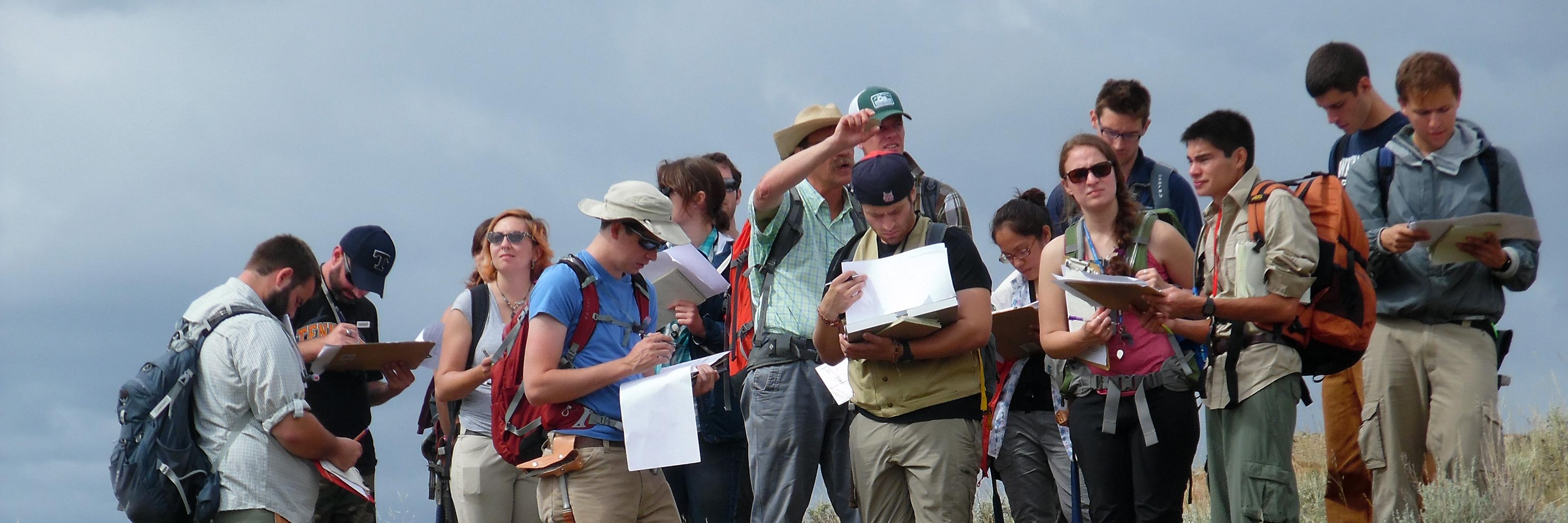Course description
This course is physically demanding. You should be in good health, capable of strenuous hiking on rugged terrain while carrying daypack and field gear.
- Prerequisites: You are expected to have completed at least the first two-three years of a standard undergraduate program in the geosciences. This would normally include an introductory course and two or more courses in the disciplines of mineralogy, petrology, sedimentology, stratigraphy, and structure/tectonics. Additional topical coursework is beneficial for some of the available areas of concentration. Students with alternative backgrounds are encouraged to apply and will be considered on a case-by-case basis.
- Curriculum: The EAS X429 curriculum is divided into two parts. The first part consists of closely supervised instruction with a 7:1 student-to-faculty ratio. A typical schedule for a week runs as follows: one to two days of close instruction (e.g. descriptions, measurement, and field examination of the stratigraphic section, use of topographic maps and air photos for location and as base maps) followed by two to three days of work applying this information to a problem (e.g. regional deformation patterns involving the lower Paleozoic stratigraphic section). Additional topics included in this first part of the course are:
- techniques of mapping simple structures on aerial photographs and topographic maps
- reconnaissance mapping of a relatively large area of moderate structural complexity
- the study of sedimentary rocks through detailed description and measurement of stratigraphic sections
- detailed mapping and reconstruction of the geologic history of a highly complex structure characterized by numerous folds and faults
- field studies of igneous and Archean metamorphic rocks
- Goals: X429 is an immersive, hands-on, field geology course. It is designed to allow you to build and integrate diverse geoscience skills to solve 4-dimensional geologic problems. Projects range from outcrop scale to regional scale and cover most subdisciplines of the geosciences. Read more about how X429 teaches geological and professional skills.
- Final study area: The second part of X429 involves a final study area project composed of mapping in an area characterized by both geologic diversity and complexity. Each student works independently in one of several FSAs and produces a final project that includes: extensive sets of different types of supporting data; geologic maps on aerial photographs (stereographic pairs) and topographic base maps; geologic cross sections; other appropriate projects of data as determined by the student; a summary of the geologic history of the region. The maps and written report for the project are due on the last day of the course.
- Field exercises: In addition to the teaching projects, there are four one-day field evaluation exercises. You will work independently of other students and faculty to collect basic observational and stratigraphic data; construct a geologic map and cross sections for the area; and decipher the geologic history of a structurally and stratigraphically diverse area that you have not previously visited.
- Focus areas: As a culmination of the intense instructional portion of the course, you are given the option to select a particular focus for the final week of intense instruction. Options for this week include: an emphasis on crystalline rocks (X429c); hydrology and environmental geology (X429e); the integration of different geophysical techniques (X429g); or stratigraphy and subsurface exploration techniques (X429s). This work is set within the overall framework that has been developed up to this point in the course, allowing you to explore how more in-depth techniques can be adapted within a field setting.



 The College of Arts
The College of Arts